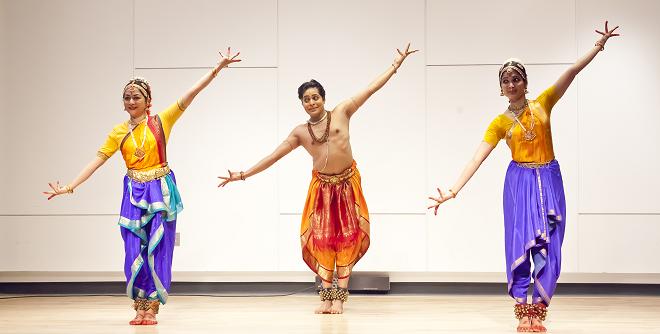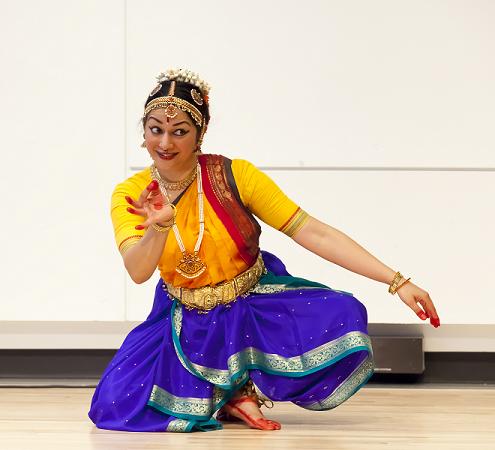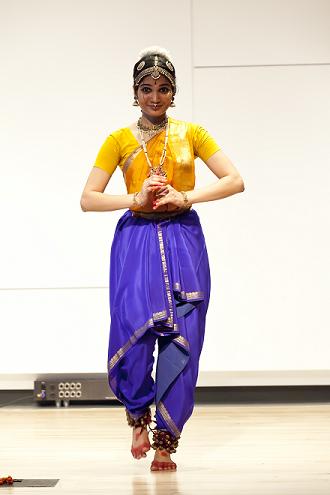Contribute
| Fabulous Presentation - Kalakshetra Style |
Janani Swamy
08/25/2011
Earlier this summer, I had the opportunity to see a Bharatha Natyam performance by local artists Soumya Ramanathan and Gayathri Srinivasan, who were joined by eminent dancer, J. Suryanarayanamurthy, who is one of India’s leading male Bharatha Natyam dancers. At the time of the performance, I told Soumya that I wished to write a review of the performance- which represented what I consider good Bharatha Natyam- the classical repertoire presented with skill and reverence without distracting frills or excess. Although a few months lapsed since the performance, the impression created by the program has lasted and is very much worth sharing with readers, dancers and dance students.
All three dancers are alumni of Kalakshetra, a premier institute for Dance and Arts in India and the origin of modern Bharatha Natyam. Together, they presented a recital that showcased the Kalakshetra bani and indeed, Bharatha Natyam at its best.
In recent years, in India and the diaspora, Bharatha Natyam has evolved in terms of concepts, repertoire and presentation. While this has added to the vastness and reach of the art form, it has also proven that Bharatha Natyam is best experienced in the form of the classical margam.
This was amply demonstrated by the evening’s presentation by these three dancers whose art is rooted in the classicism of the Kalakshetra style. The repertoire consisted of classic pieces performed with the rigor and high standard that mark this style and that take years of dedicated training to attain. The beauty of Nritta, or pure dance, was conveyed through uncluttered choreography that relied on precision and economy of movement rather than needlessly long and arithmetic passages that have become a recent trend. Abhinaya was thoughtful and highly interpretive of both lyric and mood and void of gimmickry. This was complimented by the tasteful simplicity of costume and the intimate setting of the Spring step dance studio which altogether set the stage for a wonderful rasika experience.
All three dancers presented the opening Pushpanjali in Nattai which was followed by an Alarippu in lovely Yaman Kalyani which was set to lyrics from the Thirupugazh. This was followed by the classic Saveri Jathiswaram, which was rendered by Soumya and Gayathri. The Jathiswaram has become increasingly rare in Bharatha Natyam programs, one reason being the stamina required to undertake a pure nritta piece between the opening piece and the varnam. As such, it was a pleasure to see this piece presented with poise and ease that belied the demanding choreography.
The Jathiswaram was followed the Varnam, Gokula Bala, by Sri J. Suryanarayanamurthy. This Varnam, a composition of the contemporary Bharatha Natyam Guru, Smt. Rajee Narayan of Mumbai, is a Bhakthi varnam that addresses Lord Krishna as the child of Gokula, the beloved of the Gopis, the slayer of the demoness Bhoothana and the serpent Kaliya, as the protector Govardhana Giridhara, the protector of Gajendra and as Parthasarathy who manifests as the Vishwarupa. So much was illustrated by this master dancer’s presentation- beauty of form and movement, how these well known and often presented themes can be experienced anew in the hands of capable artists and the endless possibilities of this art form. Sri Narayanamurthy’s dance also illustrated the very different Bharatha Natyam experience created by a male dancer, especially one as skilled as he. There was no compromise on bhakthi or bhava, but there was a power in the choreography and depiction of scenes such as Gitopadesha and in the overall presentation that created an impact so unique from typical interpretation.
The varnam was followed by another classic piece, Arunachala Kavi’s “Yaaro Ivar Yaroâ€, in which Gayathri depicted Goddess Sita’s intrigue when she first laid eyes on a handsome stranger. She asks, “Who is this and what is his nameâ€? Gayathri’s portrayal of Sita and of Rama was delivered with insight and leisurely involvement and reflected the skill that differentiates seasoned dancer.
Soumya presented a javali by Dharmapuri Subbaraya Iyer in which she depicted a young heroine(Mugdha Nayika) who is beckons her suitor, who is none other than Lord Padmanabha himself. Filled with love and passion, she calls out to Him to come to her side immediately and satisfy the pangs of love that have struck her ever since she was pinned down by Manmatha's (the God of Love) arrows. Soumya has an extensive repertoire of padams and javalis that cover many themes and moods of nayikas not often seen on stage and this piece was a delight to watch. Soumya’s dancing always reflects an ability that is the product of her passion for dance and dedicated sadhana.
Sri Suryanarayanamurthy then depicted the energy and abandon of Shiva’s Thandava in Swathi Thirunal composition “Shankara Sri Giri†in the ragam Hamsanandhi.
The evening concluded with the classic Paras Thillana, which again illustrated the classicism of the Kalakshetra Bani.
While the intimate setting allowed for a serene rasika experience, I couldn’t help notice that there were few young dancers and dance students in the audience. In addition to training and practice, a key element in the education and formation of a dancer is the observation and understanding of truly good dance. This not only in terms of form and technique, but in terms of the involvement, passion and sincerity that marks the art of dancers such as Soumya, Gayathri and Sri J. Suryanarayanamurthy. This strikes me especially during what is “Arangetram seasonâ€. Young dancers should, as part of their training, attend programs such as this one to draw inspiration and to understand what Bharatha Natyam is truly about. We are lucky to have talented artists like Soumya and Gayathri in the Boston area and there should be more effort within the dance community to promote programs such as this one.
You may also access this article through our web-site http://www.lokvani.com/


